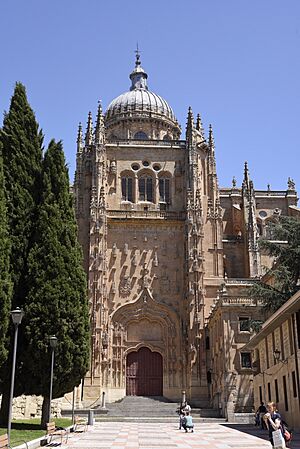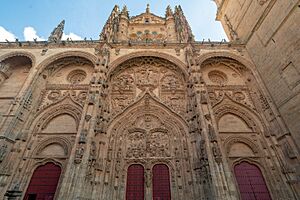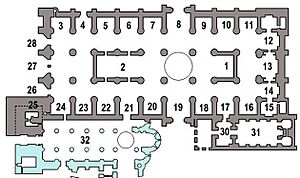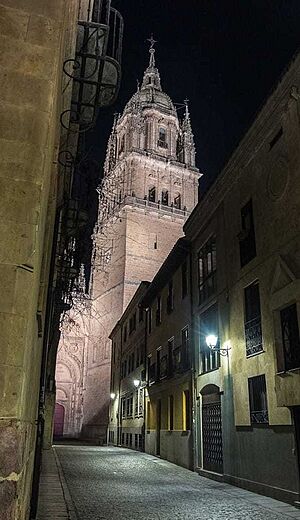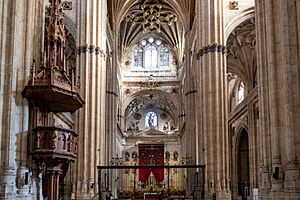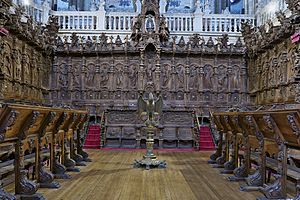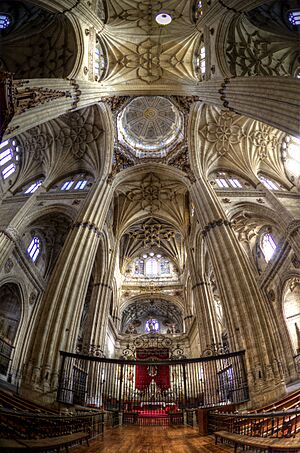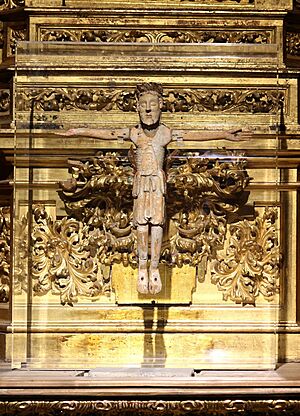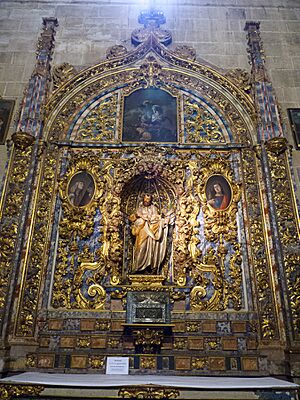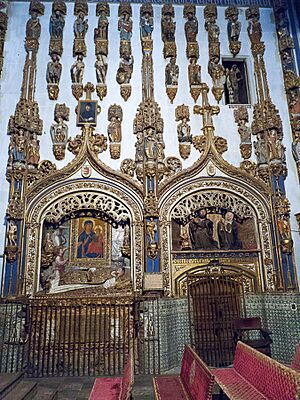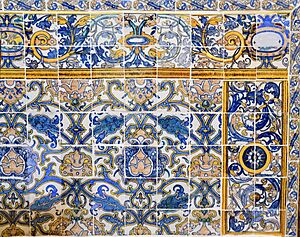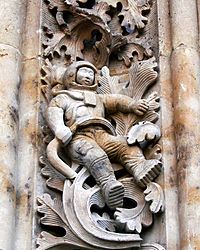New Cathedral of Salamanca facts for kids
Quick facts for kids New Cathedral of SalamancaCatedral Nueva de Salamanca |
|
|---|---|

Tower and dome of the New Cathedral.
|
|
| Religion | |
| Affiliation | Catholic Church |
| Location | |
| Location | Salamanca, Castile and León, Spain |
| Architecture | |
| Architectural type | Cathedral church |
| Architectural style | Late Gothic, Plateresque, Baroque |
| Groundbreaking | 1513 |
| Completed | 1733 |
The New Cathedral (its full name is Catedral de la Asunción de la Virgen) is one of two cathedrals in Salamanca, Spain. It stands right next to the Old Cathedral. This amazing building was constructed between 1513 and 1733. It mixes different styles like late Gothic, Plateresque, and Baroque. It was ordered by King Ferdinand V of Castile. It is one of the biggest cathedrals in Spain, and its bell tower is super tall, reaching 92 meters!
Contents
- History of the New Cathedral
- What Makes It Special
- Main Chapel
- Choir and Organs
- Interesting Chapels and Altars
- Chapel of Santiago and Santa Teresa
- Altar of the Christ of the Redeeming Agony
- Chapel of the Virgin of Lourdes
- Chapel of Nuestra Señora de la Soledad
- Chapel of the Christ of the Battles
- Chapel of San José
- Chapel of los Dolores or del Santísimo
- Chapel of la Virgen del Desagravio
- The Golden Chapel or of All Saints
- Architectural Style
- Modern Additions: The 1992 Restoration
- See also
History of the New Cathedral
The New Cathedral was built between 1513 and 1733. What's cool is that they decided to keep the Old Cathedral instead of tearing it down. At first, they thought about demolishing it. But then they decided to keep it open for people to use while the new one was being built. Even after the new cathedral was finished in the 1700s, they chose to keep the old one.
However, the New Cathedral's south wall actually rests on the north wall of the Old Cathedral. This meant the old wall had to be made stronger from the inside. The New Cathedral's tower was also built right on top of the Old Cathedral's bell tower.
Why a New Cathedral?
The idea for a new cathedral came up in the 1400s. Salamanca was growing a lot, especially because of the famous University. The Old Cathedral seemed "small, dark, and low" for the growing city. King Ferdinand the Catholic supported the idea. In 1509, he asked famous architects, Antón Egas and Alonso Rodríguez, to design the new church.
Building the Cathedral
After many discussions, the cathedral was designed to be built next to the old one. It was made from freestone from Villamayor and followed the Gothic architecture style. It has a rectangular shape with three main sections (naves) and two smaller chapels. The first stone was laid in 1512 by Bishop Francisco de Bobadilla.
Work on the cathedral stopped for most of the 1600s. It started again in the 1700s and was finally finished in 1733.
The Great Earthquake
The cathedral was badly damaged by the Lisbon earthquake on November 1, 1755. This huge earthquake caused cracks and broke stained-glass windows. After the earthquake, the dome had to be rebuilt by Juan de Sagarvinaga. The bell tower also needed to be made stronger. It was leaning and looked like it might fall!
Many architects suggested tearing it down. But Baltasar Dreveton came up with a plan to fix it. He suggested wrapping it with 8 strong chains and covering it with stone to make it more stable. This work was led by Jerónimo García de Quiñones and Manuel de los Ríos. That's why you can still see it today, covered in stones and leaning a bit from the earthquake. People in Salamanca remember this event with a tradition called "Mariquelo" every October 31st.
Changes Over Time
Around 1812, during the Napoleonic French army occupation, a block of houses north of the cathedral was torn down. This created the Plaza de Anaya and showed off the north side of the cathedral. This side wasn't originally meant to be seen so clearly, so it's not as fancy as the main entrance. However, because of this, many famous photos of the cathedral are taken from this less decorated side.
The New Cathedral was declared a national monument in 1887. In 1999, it was recognized as a Protected Environment.
What Makes It Special
The New Cathedral is one of the last two Gothic-style cathedrals built in Spain, along with the Cathedral of Segovia. It kept its late Gothic style from the 1500s to the 1700s. However, in the 1700s, two new parts were added that looked very different: a Baroque dome over the middle section and the top parts of the bell tower. This bell tower stands 93 meters tall!
The outside of the cathedral has flying buttresses and buttresses, which are typical Gothic features that help support the walls.
The inside of the cathedral looks a lot like the Cathedral of Seville. Even though the side sections (naves) are not as tall as the central one, the church feels very big and bright. This is because of how tall the ceilings are and how the space is designed. Instead of a triforium (a gallery found in older churches), there are two levels of balconies that go all around the cathedral. The pillars inside help hold up the weight of the beautiful vaulted ceilings. These ceilings have many different patterns, making them very interesting to look at.
The New Cathedral has three main sections and two extra chapels. These chapels were finished in 1520 by Juan Gil de Hontañón and Juan de Álava. Later, in 1538, Rodrigo Gil de Hontañón (Juan Gil's son) became the main builder.
The original dome was built by Joaquín de Churriguera in 1725. It was similar to the one in the Cathedral of Burgos. But the earthquake of 1755 cracked it. So, it was replaced with a new, more classical-style dome by architect Juan de Sagarvinaga, which is what you see today.
Main Chapel
The Main Chapel has a rectangular shape with a beautiful starred vault ceiling. This ceiling has the same design as the central part of the cathedral, but it's angled and colorful.
This chapel doesn't have a traditional altarpiece (a large decorated screen behind the altar). The one that was there was taken down in 1743. There is a special marble and jasper tabernacle (a small cabinet for sacred items) made by Simón Gavilán Tomé in 1750. You can also see silver containers holding the remains of Saint John of Sahagún and Saint Thomas of Villanova.
Choir and Organs
The choir area was built between 1730 and 1740 by Joaquín de Churriguera. The choir stalls, where singers sit, were made by several artists. The decorative grilles that close off the choir and the Main Chapel were made by Duperier.
Organs
The New Cathedral of Salamanca has two organs:
- The Epistle Organ: This one is in the Renaissance style and was built in the 1500s.
- The Gospel Organ: This is a Baroque-style organ built in 1744 by Master Pedro Echaverría. It was changed in the 1800s. Around 1950, a Belgian expert tuned it and was amazed that it was in such perfect condition, even though it hadn't been tuned for almost a century! In 1992, with help from the Japanese monarchy, this organ was restored to its original sound and got a new electric system for its air pumps.
Interesting Chapels and Altars
The chapels in the cathedral were designed with a similar look. Each has a space for an altar or altarpiece. Many of them have beautiful star-shaped vaulted ceilings. The grilles that close off the chapels are all different, depending on when they were made. Some altars also have colorful azulejos (painted tiles).
Here are a few notable chapels:
Chapel of Santiago and Santa Teresa
This chapel's altarpiece is dedicated to the two co-patrons of Spain. It was made by Antonio González Ramiro in 1628 with sculptures by Antonio de Paz. This chapel also holds the tombs of two important bishops of the city: Tomás Cámara y Castro and Francisco Frutos Valiente.
Altar of the Christ of the Redeeming Agony
This altar is in the north part of the cathedral's cross-shaped section. The image of Christ here is one of the most striking in the cathedral. It's an anonymous work from the 1400s, showing Christ on the cross with three nails. The painting is very realistic, showing veins and details on the body. Christ is shown as dead, with open eyes and a slightly open mouth. He even has real hair, which makes the figure seem very lifelike. This statue is carried in a procession during Holy Week in Salamanca. At the foot of the cross, there are bones and a skull, which tradition says represent Adam.
Bishop Francisco de Bobadilla, who laid the first stone of the cathedral, is buried in front of this altar.
Chapel of the Virgin of Lourdes
This chapel has images of important Church Fathers that came from the old main altar. It also has an image of the chapel's patron saint.
Chapel of Nuestra Señora de la Soledad
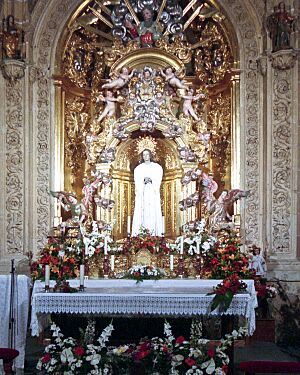
This chapel features a Baroque altarpiece by Joaquín de Churriguera. It holds a carving of Our Lady of Solitude, a dressed image made by Mariano Benlliure in 1941. This image is also carried in processions during Holy Week in Salamanca.
Chapel of the Christ of the Battles
This chapel houses the Romanesque image of the Christ of the Battles. This statue, made in the early 1100s, is flesh-colored and has four nails. Legend says that Bishop Jerome of Périgord, the first bishop of Salamanca, carried this image with El Cid during his battles against the Muslims. The altarpiece holding the Christ was made by Alberto de Churriguera in the early 1700s. The chapel also contains a container with the remains of Bishop Jerome and an image of the Virgin of Carmel by Antonio de Paz.
Chapel of San José
This chapel has a Baroque altarpiece with a beautiful image of Saint Joseph holding the Child. It also has paintings of Saint John, Mary Magdalene, and Santiago Matamoros.
Chapel of los Dolores or del Santísimo
This chapel is located under one of the towers. Its altarpiece is in a classical style and was designed by Juan de Sagarvinaga. It features an image of the Pietà (Mary holding the dead Christ) by Luis Salvador Carmona from 1760. This image is known for its realistic painting and the calm look on the Virgin's face. It is also part of the Holy Week in Salamanca processions.
Chapel of la Virgen del Desagravio
This chapel is special because it has one of the first altarpieces in Spain to use "Solomonic columns" (twisted columns). It was put together in 1664 to hold a painting of the Immaculate Conception. This painting had been damaged that same year when someone slashed the Virgin's face with a dagger.
The Golden Chapel or of All Saints
This chapel was built in 1515 by Francisco Sánchez de Palenzuela. Its architecture was designed by Juan de Álava. The walls are covered with about 110 statues that are painted gold, which is why it's called the Golden Chapel! These statues show characters from the Old and New Testaments, including apostles, saints, and prophets. Some interesting statues are Adam and Eve, which look like the figures of Apollo and Venus on the University of Salamanca's facade. There's also a spooky image of death in a niche. A magnificent Calvary (a scene of Christ on the cross) is at the main altar, with a painted background by Adiosdado de Olivares. Below it, the altar is decorated with beautiful Talavera de la Reina azulejos (tiles).
Architectural Style
The New Cathedral was started when the Gothic style was slowly changing into the new Renaissance style. This mix created the Plateresque style in Spain. However, this cathedral kept more of its Gothic look because people wanted it to match the Old Cathedral. So, the new cathedral continued to be built in the Gothic style through the 1600s and 1700s. But, in the 1700s, two parts were added that really stood out from the main style: a Baroque cupola (dome) over the middle section and the final parts of the bell tower (92 meters tall).
The new cathedral was built without destroying the old one. Instead, a wall of the new cathedral leans on the north wall of the old one. Because of this, the old cathedral had to be made stronger, and the new bell tower was built on top of the old one. Two of the main architects were Juan Gil de Hontañón and his son Rodrigo Gil de Hontañón.
The main entrance has three beautifully decorated arches. Each arch leads into one of the three main sections (naves) of the church.
Modern Additions: The 1992 Restoration
- The Astronaut: On the Puerta de Ramos (north door), you can find a very unusual sculpture of an astronaut! This was carved into the stone in 1992 by stonemason Miguel Romero. It's a tradition to add a modern element during each restoration. This particular restoration happened because Salamanca was hosting an exhibition called Las Edades del Hombre in 1993, and the door needed repairs. On September 20, 2010, the astronaut's right arm was broken due to vandalism.
- Other Ornaments: Below the astronaut, there's a lynx. To its right, you'll see a bull. Below the bull, there's a dragon holding a three-ball ice cream cone and smiling! Further to the right, near the door, are three more figures: a crayfish, a stork, and a hare. These represent water, sky, and earth in Salamanca.
See also
 In Spanish: Catedral Nueva de Salamanca para niños
In Spanish: Catedral Nueva de Salamanca para niños


